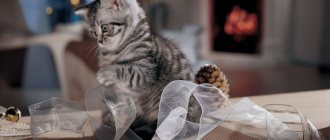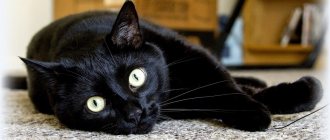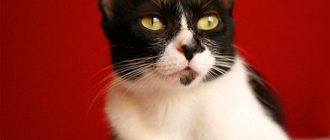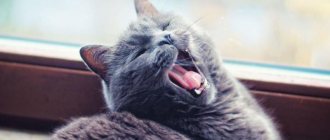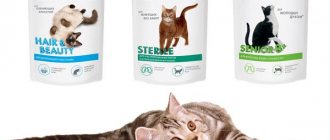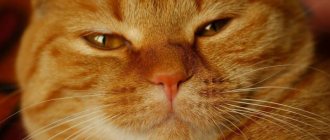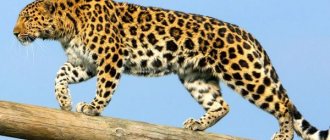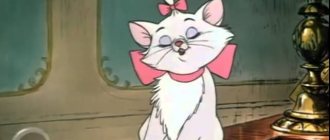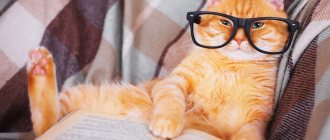Since ancient times, humans have been convinced of the supernatural powers of felines. His faith extends to nine lives, contact with the otherworldly, and the fact that a black cat is a source of trouble. All this only confirms that humans lack reliable information about the origin of the purring creature.
Therefore, in some countries, felines still act as idols and are worshiped. But red cats deserve special attention, which, according to legends and ancient tales, are called upon to bring happiness to the home.
Patterned
Any color can be patterned.
The shape of the pattern is determined by a series of T (tabby) genes. And such genes are present in the genotype of absolutely every cat. But, as you know, not every cat is striped or spotted. It's all about another gene - A (agouti). This gene either “turns on” or “turns off” as the hair grows, coloring the hairs in transverse rings with alternating dark and light tones. Decoding the colors of cats begins with a search for two genes in the genotype - T and A. If there is at least one A, the cat will be patterned. If there are two aa in the genotype (homozygous recessive set), the fur coat will be colored evenly, since without ticking (coloring the fur in stripes) a pattern is impossible. So, what does the color of a tabby cat mean? The answer is obvious: the cat is a carrier of the dominant agouti gene (A). Now let's look at the tabby gene (T):
Ta (Abyssinian) is dominant to T (stripes), and T is dominant to Tb (marble). But there are still spots! But with them it’s more complicated: either there is a specific gene that allows spotting to appear, or the spots are the result of the work of a group of modifier genes that “break” the stripes (the latter is more likely).
Patterned “silver” and “gold”
Patterned colors look extremely beautiful and impressive if breeders pay attention not only to improving the pattern itself, but also the background. Thanks to the work of an additional group of polygenes, the yellow-brown undercoat can be given a bright golden-sandy hue, making it “golden,” and if the patterned color is combined with the dominant Silver gene (I), then the beige tone of the undercoat changes to bright white and the result is “silver.”
A table that clearly shows how, as a result of various selections, the background shade can differ using the example of a spotted pattern
“Cold” tone of the undercoat, especially on the body, and slight yellowness on the face and paws (BRI n 24)
Bright, richly “warm” tone of the undercoat. This cat has gold in her ancestry, if not for her orange eyes, she could very well be one. (BRI n 24)
For chocolate color, the golden shade of the background is natural; the chocolate gene gives a “warm” tone not only to the main color, but also to the background. This is why it is so difficult to work with chocolate silver; it is extremely difficult to achieve a clear contrasting pattern and a clean background without yellowness
(BRI b 24)
The “warm” tone of the undercoat of this golden animal was obtained as a result of many years of work by breeders. Please note that the polygenic complex that gives the golden hue to the undercoat indirectly affects the main pigment, as a result of which the pattern on the body becomes brown instead of black. Nevertheless, genetically it is precisely black, which can be seen in the places of the greatest accumulation of pigment - the tip of the tail, paw pads, and the rim of the nose. (BRI ny 24)
| Table of Rufisms using the example of black silver spotted British cats (BRI ns 24) | |
| This cat has small rufisms on his face, chest and paws; perhaps his closest ancestors have solidi, in which selection to weed out rufisms is impossible, they do not appear on a single color. Orange eyes also indirectly indicate the presence of such ancestors. (BRI ns 24 62) | This cat is pure silver with no yellow, bred through breeding for silver over many generations. (BRI ns 24 64) |
List of cat genes responsible for mutations of ears, tails and paws
| № | ( or ) | Comments | |
| 1 | FdFd | lop-eared | in addition to ear deformation in cats, the allele causes osteochondrodysplasia |
| 2 | Fdfd | lop-eared | healthy animal |
| 3 | Cu- | ears rolled back | |
| 4 | MM | embryo death | that's all |
| 5 | mm | no tail or bob tail | -//- |
| 6 | btbt | bob ponytail | only |
| 7 | kk | wedge-shaped vertebrae | believed to be responsible for deformed tails in cats, and |
| 8 | MkMk | the embryo does not develop | only munchkin and other dwarves |
| 9 | Mkmk | short legs | -//- |
Note: the genetics of the tails of all bobtails except the Japanese are unknown, presumably bob tails are inherited polygenically; The American Ringtail's tail is probably determined by a recessive gene (designation unknown).
List of cat genes responsible for rare mutations
| № | ( or ) | Comments | |
| 1 | sfsf | baldness around the eyes and mouth | probably the breed-forming gene of Lykoi |
| 2 | sasa | cotton wool (fine, brittle and thick) | |
| 3 | Cat- | ||
| 4 | brbr | brachyuris (short-tailed) | only for |
| 5 | Pd | (extra toes) | |
| 6 | Sh- | (fusion of toes) | |
| 7 | Rh- | (kangarooism) | extra joint (toe), short foot |
| 8 | dpdp | four ears | also leads to underbite, smaller eyes and a tendency to lethargy |
| 9 | tete\mcmc | ||
| fckfck | |||
| 10 | chch | death syndrome | |
| 11 | popo | only the first type | |
| 12 | rdgrdg | ||
| 13 | Rdy- | only in Abyssinian cats | |
| 14 | rtrt | found only in | |
| 15 | ndnd | ||
| 16 | slsl | ||
| 17 | Ga-1-\ga-2ga-2 | ||
| 18 | mpsmps | ||
| 19 | mama | ||
| 20 | splspl | ||
| 21 | hyhy | ||
| 22 | trtr | ||
| 23 | ewew | found among Burmese | |
| 24 | sptspt | found in | |
| 25 | hmahma\hmbhmb | ||
| 26 | haghag | ||
| 27 | hcehce | ||
| 28 | Ph- | ||
| 29 | hoho | ||
| 30 | tfmtfm | ||
| 31 | hcmhcm |
Shaded and chinchilla colors of the British cat
The next group of silver colors: shaded and “chinchilla” (shell).
If “smoky” colors look light, then shaded and chinchilla colors look almost white, with a characteristic “spraying” at the very tips of the hairs. In cats with a shaded color, this “spraying” occupies only a sixth of the hair, and in individuals with a chinchilla color it takes up even less – an eighth. Naturally, no one measures the length of a hair with a ruler, much less 1/6 or 1/8 of its color. And anyway, we call all such elegant pussies chinchillas. The following points should be noted regarding shaded and shell colors.
1. Both colors are coded as “smoky” colors, but with the numbers 11 – shaded and 12 – chinchilla (shell). For example, BRI ns11 – black, shaded. Outwardly, she looks white, with a black “spray”, and her paw pads, the rim of her nose and the rim of her eyes should be completely black.
2. Both colors mean that there should be no closed stripes on the limbs, tail, or chest (such stripes on the chest are called a necklace). Shaded cats should have shaded hair on the head, ears, sides, back and tail.
3. Chinchilla colors must have bright green eyes. Shaded, that is, slightly darker, have the right to have yellow (or orange) eyes. Only then the eye color coding is then added to the color coding: 62, for example, BRI ns11 62.
| British cat color shaded (Shaded) (BRI ns11) | British cat chinchilla color (Chinchilla) (BRI ns12) |
| British cat color golden shaded (BRI ny11) |
No less interesting are the golden colors (coded by the letter y, which is indicated by analogy with the letter s in the designation of “silver”). However, this is even more rare for the British breed.
The chin, belly and lower part of the tail should be painted a pale apricot color, the nose - brick, while a transition to black or dark brown is considered quite acceptable. The paw pads of animals of the color in question are black or dark brown, and their eyes are green.
British chinchilla cats look amazingly rich and elegant. Their fur is similar to a fox fur coat. The chinchilla was developed in the early 1970s. English breeder Norman Winder, who crossed the Persian chinchilla with the British shorthair. The breeder was attracted by the luxurious silver coat of the chinchilla and the power of the British. The experiment was a success: in 1973, Winder demonstrated a new breed at an exhibition, which was called British black with tipping (“spraying”). This color was recognized in 1980 in England by the board of directors of the cat lovers club.
Somali red cats
The Somali cat is also a “domestic fox.” Her ancestor was the Abyssinian cat. Nobody knows when and how this breed came about. Some breeders believe that this animal is the result of genetic mutations, others believe that the female was crossed with a long-haired breed. The Somali red cat is aesthetic and flexible. This is an animal with large pointed ears, which are topped with small tassels.
A distinctive feature of the breed is the frill, which is located on the neck and tail. Colors of Somali cats
challenging and worthy of attention. The coat can be beige, brown, orange, red and red. All these tones, when mixed, will create a ticked color. Somalis enjoy frolicking, running and jumping. They feel great alone, without requiring special attention.
Colors of the “black” group
The B (black) gene is responsible for the normal formation of black pigment. Under the influence of the b gene, the pigment oxidizes - a brown color is obtained. But B suppresses the action of b (capital letter - dominant, lowercase - recessive gene). Thus, BB and Bb cats look the same black, and if the kitten inherited two bb from its parents, it will be brown (rich chocolate) in color. Kittens inherit one chromosome from each parent. Therefore, when crossing individuals BB plus Bb, “chocolates” will not be born - there is nowhere to get two bb.
The bl gene oxidizes the pigment even more strongly than the b gene, resulting in a light, warm shade of brown called “cinnamon.” But b and B suppress bl, so the kitten must get bl from both parents, otherwise it will not be a cinnamon.
When the genetic codes for cat colors include D (d), we are talking about strengthening or lightening the pigment. Gene D makes the color rich and allows the pigment to be densely distributed in the fur: cat B_DD is black. The d gene “mutes” colors, forming less bright, calm shades: cat B_dd is gray. But kitten B_Dd will be black, because gene D is dominant to d and blocks it.
Kittens will turn out purple if they inherit two “weak” genes from their parents: bl (chocolate) and dd (lightening). Thus, lilac is bleached chocolate.
British red color standard
There is a uniform standard of coat quality and color for all British Shorthairs. Felinologists are trying to preserve this indigenous breed unchanged. Therefore, experts carefully monitor all experiments aimed at diversifying the colors of cats.
- The coat is short, elastic, silky. In red color, stiffer guard hair is allowed, which should not fit tightly to the body.
- Bright red British cats have an undercoat of the same shade as the main coat. Bald spots of a different color and uneven coloring are not allowed.
- The chin, tip of the tail and a small area on the belly may be slightly lighter than the base coat shade. In pedigree breeding, such a transformation is not welcomed, but at exhibitions experts are loyal to it.
Additional requirements apply to eye color, paw pads and nose:
- The pupil is always colored in honey, orange or copper tones.
- The color of the skin of the nose and pads is darker than the base color - brick, terracotta or bleached brown.
In red British cats, the tabby pattern will always be contrasting. There should be clear lines on the chest and neck. The same pattern starts from the corners of the eyes and covers the cheeks. On the paws and tail there are distinguishable encircling rings of the primary color.
Acceptable variations and deviations in British Reds
All colors containing red in the British are divided into several categories.
The first includes standard solid colors (solid). In this case, the wool will be dyed evenly along its entire length. The British acquired this color as a result of crossing with the Persian longhaired breed.
In the future, such inter-tribal unions were prohibited due to the increase in hair length, but the color was fixed and consistently transmitted with proper breeding.
The next category is red smoky, which is formed when the pigment is unevenly distributed throughout the hair. The root part remains light, only 4/5 of the length is colored.
The fur of red British cats seems evenly colored, but when moving, lighter areas of the hair are revealed, resulting in the effect of a shimmer of shades.
Another color option is silver-red, shaded. Here the wool is pigmented to 1/3 of its length, and 2/3 remains bleached. At the same time, the nose, eyes and lips of shaded red British kittens have a contrasting dark edging.
The next variety of red is the red chinchilla. The pigment appears only at the tip of the hair (1/8 of the length), and the rest of the hair is not dyed. The term “cameo” is used for British people with this coat color.
The acromelanic color-point (red-point) has a lighter shade of body, in contrast to the mask on the face, the tips of the ears, the ends of the paws and the tail.
British Red kittens can be born bicolor or particolor. This is a combination of white and red colors, which is considered traditional for many cat breeds. They differ only in the amount of white wool.
- from 30 to 50% white - bicolors;
- from 50 to 90% white - particolors;
The rarest combinations for cats of the British breed:
- Harlequins are 90% white and 10% red.
- Vans - maximum white color. Only the tail and a few markings on the head near the ears remain in red.
Rules for caring for a British pet's coat
The rules for caring for the coat of red British cats do not differ from cats of this breed with other colors.
- The animal is combed 1-2 times a week to remove excess hair. Both standard combs and special mittens are suitable for this. A thick undercoat will require regular grooming. You should not let it fall into a tight felt boot, which prevents the skin from breathing freely.
- During active molting, treatment is repeated daily, and sometimes several times a day.
- Almost all cats do not like water, so thorough combing and treating the coat with a damp cloth is the best hygiene procedure for a red British cat.
Coat quality is an objective indicator of a cat's health. As soon as it loses its shine, begins to roll into untidy icicles or falls out intensively, it means your pet has health problems.
This is interesting! To maintain a high-quality red color, felinologists recommend introducing seafood into the cat’s menu. They contain a lot of iodine, which makes the color rich.
Cinnamon - red tortoiseshell color in the British
Tortoiseshell coloring is common in British cats. It is formed by a harmonious combination of evenly colored red and black hairs. But in the case of ginger cats, cinnamon (cinnamon) replaces black and goes with any shade of red.
There are no strict rules regarding the size and number of spots in the British tortoiseshell cat color variety. It is genetically impossible to predict how they will lie on the wool, and therefore any arrangement is allowed.
In tri-colored British tortoiseshell cats, white is added to the two standard spot colors (red-black or cinnamon). Such animals are sometimes called patchwork animals, although this definition does not accurately describe their appearance.
Usually female kittens are born with a tortoiseshell color. However, nature sometimes experiments unsuccessfully, and cats become the owners of an additional chromosome (XXY). In this case, they are also born “turtles” and, most likely, will be infertile.
Cat eye manicure with drops 2021
One of the most original cat eye designs is drops. Craftsmen make them in different ways, but most often it is a combination of glossy and matte topcoats.
Photo: o-tendencii.com
Photo: kleo.ru
Colors of the “red” group
The O gene is responsible for “red” colors, from a bright almost brick shade to barely noticeable cream tones. The O gene is found only on the female chromosome, so a cat (XY) can carry only O or only O, but in the genotype of a cat (XX) there can be different combinations (OO, oo or Oo). Lowercase o is a recessive gene suppressed by O. Moreover, O is also dominant in relation to B, i.e. suppresses black colors. Thus, a cat that received the O gene from its mother will definitely be red (of course, if there is no W gene, which suppresses color). And a cat can be born red, and like this: BBOoDD (the first O suppresses B, the recessive o “cannot cope with the second B” - we get a tortoiseshell color).
If DD is adjacent to OO, the orange colors of the cats will be sunny and bright. If dd, the fur will acquire a delicate cream tone, since dd lightens not only black (B), but also red color.
Cymrik breed: fluffy red beauties
In the 60s, felinologists noticed the Cymrik cat breed. They have lush fur, a rounded head, compact body build, developed muscles, and the main difference is that they do not have a tail. Instead of this part of the body there is a small cartilage.
The real wealth is the animal's fur. It is long, and under it there is a thick undercoat. The furry pets of this breed come in different colors: delicate white, majestic black, playful tabby and sunny red. Pets have a balanced character, they can be trained, and are good at learning various tricks. Thanks to its friendly nature, the pet communicates with every member of the family. Domestic cats with red fur are very cute creatures, fluffy and bright.
Colors with white spots
White areas may appear on any colored spot. Sometimes their presence is mandatory, and in other cases it is a serious fault or even a disqualifying defect (see the standard of the specific breed).
So, white areas appear due to the action of the dominant white spotting gene S. Moreover, the white area is larger if the cat is homozygous, that is, SS. Heterozygous Ss individuals tend to be more colorful. With ss, there are no white spots at all (except for a small white area under the chin, which appears under the influence of other, “secondary” genes).
There are many modifier genes that affect the location, shape and number of white spots. Unfortunately, the genetics of cat colors does not yet provide a clear answer to the question of which genes and how they influence the degree of spotting. For this reason, working with colors such as van, harlequin and bicolor is quite difficult. It is no easier for those who strive to get perfect “socks” or an even white “mask” - even two excellent parents give birth to kittens with “tight” socks or “masks” that go beyond the desired boundaries.
spotted tabby
A color in which there are separate spots on the body, ideally clear and not merging, uniform on the sides and back. It is formed with the help of the main Tabby genes and a complex of polygenes that “tear” the pattern into separate spots. Spotted and striped colors often form multiple transitional forms, and all these options are always classified as spotted color, because the stripes tend to “tear” as the animal grows older. Therefore, spotted is the most common color among the British patterned. Marble color is less susceptible to the action of “tearing” polygenes, because this is a wider and denser pattern, so only marble that is completely torn into spots is classified as a stain, while marble that has only been slightly exposed to polygenes will look like marble. In any case, the spotted pattern clearly shows which color was used to form the spot.
| Diagram showing how brindle and merle colors are transformed into spotted colors by polygenes. |
| Various modifications of spotted color | |
| small dots based on ticked color | round polka dots based on brindle color |
| loose large stains based on marble | rosette spots based on marble |
| Modifications of marble pattern (classic and bordered) |
This is true for all patterned colors - they value the correctness and clarity of the pattern. And also, according to the standard, a patterned animal must have a warm undercoat tone, which can vary from light sand to rich beige.
| Quite a contrasting pattern. At the same time, we see an intermediate option between brindle and spotted - dotted stripes along the ridge, the spots are not located in a checkerboard pattern, but in the form of vertical broken stripes, partially turning into spots. |
| Low-contrast blurry, too light pattern, fuzzy spots, blending into the background. Often, such a pattern is obtained as a result of mating with shaded ones, it is like an intermediate option between a chinchilla and a silver tabby, I call it a “hedgehog”. |
| Table showing possible problems with the patterned color using black silver marbled pattern (BRI ns 22) as an example. | ||
| Correct clear pattern, contrasting to the light background | The pattern is tipped like the Russian Blue breed (the hairs at the end have light tips), so it looks as if it was sprinkled with powder | Veil-like, light, not deeply colored, tipped pattern. Intermediate between chinchilla and silver tabby |
Manicure "cat's eye" with stamping
Typically, a cat's eye does not need additional decoration. But you can give it a new sound by stamping on top. For example, so that the sparkling base shines through the solid black pattern.
Photo: salonkitaigorod.ru
Photo: ladyneeds.ru
Interesting facts, beliefs and signs about black Britons and more
The black breed of British cats traditionally arouses interest and curiosity. The signs accompanying these animals are diverse not only in nature, but also in geographical location.
- The black cat is the only animal that has its own holiday. It was founded by Italian cat lovers and falls on November 17th.
- “It will be unlucky if a black cat crosses the road” - this is not the common belief in all countries. Black Britons are very lucky. In England, they are endowed with positive properties, and the woman who has such a cat will always be the center of attention.
- The Irish believe that the charcoal anthracite cat brings wealth and prosperity.
- Even superstitious British sailors willingly took black cats on risky voyages. They believed that animals of this color bring good luck.
- In Russia there has always been an ambivalent attitude towards black cats. Having met them, in the old days people were baptized and cursed the evil one. But at the same time, they believed that black cats scared away thieves and guarded the house.
- Of all the breeds that have been officially registered in the world, only 22 have representatives of pure black color. The British Shorthair is one of them.
There is also an interesting observation: the population of black Britons is larger in cities than in rural areas. According to one version, this is due to the fact that black cats adapt better to urban conditions than their tabby or tortoiseshell counterparts.
Such “fatal” Britons, as a rule, are created by wealthy people, extraordinary personalities, prone to exaltation. They rarely live alone; the doors of their home are usually open to numerous guests.
It has been noticed that even the British, who are reserved and selfish by nature, show sociability in such conditions and often become the center of attention.
Genetics of the red (red) color of the British
The British Shorthair breed allows for approximately 250 different color combinations, with solid colors playing a major role. Ginger cats are not unique here, they are often found in litters and were once even quantitatively ahead of the blue-gray color that is considered traditional for the British.
All the tools of the genotype take part in the process of color formation: chromosomes and genes, alleles, loci and pigmentation.
- The main role in the formation of the red color in the British is played by the pigment pheomelanin - elongated ellipsoidal granules that reflect light in the range of red, yellow and orange shades.
- Genes are a library of hereditary data that is passed on from parents to offspring and continues the chain of ancestral connections ad infinitum.
- Alleles come in different forms that genes can take on. They are located on certain parts of the chromosomes - in the example of red British cats, this is a very important point.
- Locus is the location of a gene (allele) in an ordered list of chromosomal compounds.
There are 19 pairs of chromosomes in a cat's set. They store the hereditary instructions, and any deviation from the norm ends in an uncontrolled mutation. British redheads are not subject to this risk, as they are an ancient breed with an established genotype.
Genes and chromosomes that influence the formation of red color are distributed as follows:
- The O (orange) gene is responsible for the production of the red pigment pheomelanin in the British (and not only in them). It has only one permanent locus attached to the X chromosome, which determines the sex of the future kitten.
- The O gene exists in 3 alleles: OO (natural red), Oo (red and black tortoiseshell British), oo (red is blocked and does not cause pheomelanin pigmentation). The final example in practice means only one thing - the cat will be black.
- For ginger cats, there are 3 color combination options: OO, oo and Oo. For red British cats, only 2 options are possible - O and O, since they have one X chromosome.
- According to the laws of genetics, a British cat inherits the orange gene from its mother. Therefore, in a pair with a red mother and a blue-gray father, male kittens will definitely receive the properties of the red gene, and the female cats will be tortoiseshell, cream or blue.
All British red coats have a tabby pattern on their coats. It is formed under the influence of the A gene (agouti) and exists in two alleles: dominant A and paired homozygous aa. In the second case, agouti suppresses another important component of the genotype - the T (tabby) gene, which is responsible for the ornamentation on the fur coat.
The unique property of the red color is that aa (not agouti) has no effect on it. Therefore, all red British cats are always tabby.
The L gene is also involved in the formation of red color. Thanks to him, purebred British cats have short and thick hair.
Little red cats Napoleons
A unique furry animal is a cat of the Napoleon breed. Why this name? Because fluffies are small. And as everyone knows, the great commander was short in stature. In appearance, Napoleon cats are similar to Persian cats and munchkins.
The weight of cats of this breed is 2-3 kg, they have a flattened muzzle and large paws. Napoleon cats come in two varieties: classic - they have long legs and extreme - they have short legs. There are four main types of color: gray, white, peach and red. Pets do not like to be alone and unattended; they are trusting and peaceful, and can easily get along with the other inhabitants of the apartment.
© shutterstock
Is it only cats?
There is a persistent myth that only cats can be carriers of tortoiseshell coloring - due to the fact that their sex chromosomes look like XX and make it possible for both black and red colors to appear simultaneously. It is not true. It is also not entirely true that, according to statistics, for every three thousand tortoiseshell cats, only one cat of this color is born - and that one is somehow sick, defective and practically sexless.
Tortoiseshell cat or tortoiseshell cat?
The quirks of nature are much more diverse and sophisticated than our understanding. Genetic solitaire games sometimes produce unpredictable results that are difficult to explain from a scientific point of view. For example, felinologists claim that the birth rate of tricolor cats directly depends on the region of their residence - scientists have not yet found an explanation for this phenomenon. But statistics on this matter, alas, are inaccurate—systematic studies have not yet been conducted.
Tortoiseshell cats
Contrary to popular belief, tortoiseshell - calico - cats do exist. But in order for the “female” color to appear, the cat must have a certain gene anomaly: the formula of their sex chromosome set is XXY. Such males are usually sterile, although there are exceptions.
Quite a lot of tricolor chimera cats are known. They can be anatomically and behaviorally similar to cats, practically do not mark their territory, do not react to females in heat and, accordingly, do not give birth to offspring. Calico-colored cats are more common than “tortoises”; they are usually cryptorchids - but that’s a completely different story.
Since the nineteenth century, felinologists from different countries have described many tricolor cats. Unfortunately, most of them were not only sterile, but also did not live long, since along with the genetic mutation they received various serious diseases.
Cat eye manicure - photos and ideas
Cat's eye can be used alone or in combination with other design elements. Moreover, the same coating can be applied in different ways. Get inspired by our selection of photos!
Photo: mykaleidoscope.ru
Photo: vanilla.su
Photo: semilac-shop.ru
Photo: modnail.ru
Photo: o-tendencii.com
Photo: moscow.sm-news.ru
Photo: ladywomans.ru
Photo: zen.yandex.ru
Photo: info-design-nail.ru
Photo: zen.yandex.ua
Photo: almode.ru
Photo: almode.ru
Photo: pinterest.com
Photo: almode.ru
Photo: catherineasquithgallery.com
Photo: fashionadvice.ru
Photo: privately.ru
Photo: tvojmanikjur.ru
Photo: trendory.ru
Photo: o-tendencii.com
Photo: pinterest.ru
Photo: almode.ru
Photo: almode.ru
Photo: almode.ru
Photo: almode.ru
Did you like the post? Subscribe to our channel in Yandex.Zen, it really helps us in our development!
Character of British pets
Representatives of the British breed belong to the category of pets with a difficult character.
- Sociable, but do not allow familiarity. You can pick up a British cat only if she is currently in the mood for it. Any violence or action against the will is regarded as an insult. The cat may proudly walk away, or it may bite.
- The Briton is not prone to active group games. He will most likely stay in a safe place and look down on all the fun.
- Very persistent in expressing their own demands. There are times when cats of this breed do not eat for a long time just because they want to change the place for their bowl.
There is a tendency towards aggression in the behavior of British Shorthairs. But it is never groundless. If the cat does not feel discomfort, then it will not terrorize the household with its bad inclinations.
Red representatives of the Ural Rex
The Ural Rex breed is considered unique, as it was obtained naturally; humans did not participate in its development. An unusual curly-haired cat lived in the Urals, then she was brought to a nursery in Moscow, where breeders began improving the breed.
© shutterstock
Ural rexes are medium-sized. The cat's fur is curled in the form of thick small curls. Often you come across Ural rexes of chocolate, blue, tortoiseshell, and bright red shades. Representatives of this breed like to communicate, they love to sleep in their master's bed, they treat family guests calmly, and they can allow themselves to be petted.
